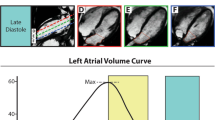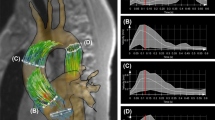Abstract
Atrial fibrillation (AF) is associated with embolic stroke due to thrombus formation in the left atrium (LA). Based on the relationship of atrial stasis to thromboembolism and the marked disparity in pulmonary versus systemic thromboembolism in AF, we tested the hypothesis that flow velocity distributions in the left (LA) versus right atrium (RA) in patients with would demonstrate increased stasis. Whole heart 4D flow MRI was performed in 62 AF patients (n = 33 in sinus rhythm during imaging, n = 29 with persistent AF) and 8 controls for the assessment of in vivo atrial 3D blood flow. 3D segmentation of the LA and RA geometry and normalized velocity histograms assessed atrial velocity distribution and stasis (% of atrial velocities <0.2 m/s). Atrial hemodynamics were similar for RA and LA and significantly correlated (mean velocity: r = 0.64; stasis: r = 0.55, p < 0.001). RA and LA mean and median velocities were lower in AF patients by 15–33 % and stasis was elevated by 11–19 % compared to controls. There was high inter-individual variability in LA/RA mean velocity ratio (range 0.5–1.8) and LA/RA stasis ratio (range 0.7–1.7). Patients with a history of AF and in sinus rhythm showed most pronounced differences in atrial flow (reduced mean velocities, higher stasis in the LA). While there is no systematic difference in LA versus RA flow velocity profiles, high variability was noted. Further delineation of patient specific factors and/or regional atrial effects on the LA and RA flow velocity profiles, as well as other factors such as differences in procoagulant factors, may explain the more prevalent systemic versus pulmonary thromboembolism in patients with AF.





Similar content being viewed by others
References
Feinberg WM, Blackshear JL, Laupacis A, Kronmal R, Hart RG (1995) Prevalence, age distribution, and gender of patients with atrial fibrillation. Analysis and implications. Arch Intern Med 155(5):469–473
Singer DE, Albers GW, Dalen JE et al (2008) Antithrombotic therapy in atrial fibrillation: American College of Chest Physicians Evidence-Based Clinical Practice Guidelines (8th Edition). Chest 133(6 Suppl):546S–592S
Bernhardt P, Schmidt H, Hammerstingl C, Luderitz B, Omran H (2005) Patients with atrial fibrillation and dense spontaneous echo contrast at high risk a prospective and serial follow-up over 12 months with transesophageal echocardiography and cerebral magnetic resonance imaging. J Am Coll Cardiol 45(11):1807–1812
Transesophageal echocardiographic correlates of thromboembolism in high-risk patients with nonvalvular atrial fibrillation. The Stroke Prevention in Atrial Fibrillation Investigators Committee on Echocardiography. Ann Intern Med 128(8):639–647 (1998)
Fatkin D, Kelly RP, Feneley MP (1994) Relations between left atrial appendage blood flow velocity, spontaneous echocardiographic contrast and thromboembolic risk in vivo. J Am Coll Cardiol 23(4):961–969
Goldman ME, Pearce LA, Hart RG et al (1999) Pathophysiologic correlates of thromboembolism in nonvalvular atrial fibrillation: I. Reduced flow velocity in the left atrial appendage (The Stroke Prevention in Atrial Fibrillation [SPAF-III] study). J Am Soc Echocardiogr 12(12):1080–1087
Leung DY, Black IW, Cranney GB, Hopkins AP, Walsh WF (1994) Prognostic implications of left atrial spontaneous echo contrast in nonvalvular atrial fibrillation. J Am Coll Cardiol 24(3):755–762
Handke M, Harloff A, Hetzel A, Olschewski M, Bode C, Geibel A (2005) Left atrial appendage flow velocity as a quantitative surrogate parameter for thromboembolic risk: determinants and relationship to spontaneous echocontrast and thrombus formation—a transesophageal echocardiographic study in 500 patients with cerebral ischemia. J Am Soc Echocardiogr 18(12):1366–1372
de Divitiis M, Omran H, Rabahieh R et al (1999) Right atrial appendage thrombosis in atrial fibrillation: its frequency and its clinical predictors. Am J Cardiol 84(9):1023–1028
Connolly SJ, Ezekowitz MD, Yusuf S et al (2009) Dabigatran versus warfarin in patients with atrial fibrillation. N Engl J Med 361(12):1139–1151
Ozer O, Sari I, Davutoglu V (2010) Right atrial appendage: forgotten part of the heart in atrial fibrillation. Clin Appl Thromb Hemost 16(2):218–220
Bilge M, Eryonucu B, Guler N, Erkoc R (2000) Right atrial appendage function in patients with chronic nonvalvular atrial fibrillation. Jpn Heart J 41(4):451–462
Klein AL, Grimm RA, Black IW et al (1997) Cardioversion guided by transesophageal echocardiography: the ACUTE Pilot Study. A randomized, controlled trial. Assessment of Cardioversion Using Transesophageal Echocardiography. Ann Intern Med 126(3):200–209
Klein AL, Grimm RA, Murray RD et al (2001) Use of transesophageal echocardiography to guide cardioversion in patients with atrial fibrillation. N Engl J Med 344(19):1411–1420
Manning WJ, Silverman DI, Gordon SP, Krumholz HM, Douglas PS (1993) Cardioversion from atrial fibrillation without prolonged anticoagulation with use of transesophageal echocardiography to exclude the presence of atrial thrombi. N Engl J Med 328(11):750–755
Manning WJ, Silverman DI, Keighley CS, Oettgen P, Douglas PS (1995) Transesophageal echocardiographically facilitated early cardioversion from atrial fibrillation using short-term anticoagulation: final results of a prospective 4.5-year study. J Am Coll Cardiol 25(6):1354–1361
Rozenberg V, Boccara F, Benhalima B, Lamisse N, Buyukoglu B, Cohen A (2000) Comparison of echocardiographic markers of embolism in atrial flutter and fibrillation: frequency of protruding atherosclerotic plaques in the thoracic aorta. Echocardiography 17(6 Pt 1):555–562
Fluckiger JU, Goldberger JJ, Lee DC et al (2013) Left atrial flow velocity distribution and flow coherence using four-dimensional FLOW MRI: a pilot study investigating the impact of age and Pre- and Postintervention atrial fibrillation on atrial hemodynamics. J Magn Reson Imaging 38(3):580–587
Lee DC, Markl M, Ng J, et al (2015) Three-dimensional left atrial blood flow characteristics in patients with atrial fibrillation assessed by 4D flow CMR. Eur Heart J Cardiovasc Imaging
Markl M, Lee DC, Ng J, et al (2015) Left atrial 4-dimensional flow magnetic resonance imaging: stasis and velocity mapping in patients with atrial fibrillation. Invest Radiol
Markl M, Harloff A, Bley TA et al (2007) Time-resolved 3D MR velocity mapping at 3T: improved navigator-gated assessment of vascular anatomy and blood flow. J Magn Reson Imaging 25(4):824–831
Watson T, Shantsila E, Lip GY (2009) Mechanisms of thrombogenesis in atrial fibrillation: Virchow’s triad revisited. Lancet 373(9658):155–166
Esmaeilzadeh M, Sadeghpour A, Fazlinezhad A et al (2008) Comparison of transesophageal echocardiographic assessment of right and left atrial appendage functions. Iranian Cardiovascular Research Journal 1:145–149
Subramaniam B, Riley MF, Panzica PJ, Manning WJ (2006) Transesophageal echocardiographic assessment of right atrial appendage anatomy and function: comparison with the left atrial appendage and implications for local thrombus formation. J Am Soc Echocardiogr 19(4):429–433
Di Biase L, Santangeli P, Anselmino M et al (2012) Does the left atrial appendage morphology correlate with the risk of stroke in patients with atrial fibrillation? Results from a multicenter study. J Am Coll Cardiol 60(6):531–538
Cai H, Li Z, Goette A et al (2002) Downregulation of endocardial nitric oxide synthase expression and nitric oxide production in atrial fibrillation: potential mechanisms for atrial thrombosis and stroke. Circulation 106(22):2854–2858
Zotz RJ, Muller M, Genth-Zotz S, Darius H (2001) Spontaneous echo contrast caused by platelet and leukocyte aggregates? Stroke 32(5):1127–1133
Markl M, Fluckiger J, Lee DC, Ng J, Goldberger JJ (2015) Velocity quantification by electrocardiography-gated phase contrast magnetic resonance imaging in patients with cardiac arrhythmia: a simulation study based on real time transesophageal echocardiography data in atrial fibrillation. J Comput Assist Tomogr 39(3):422–427
Funding sources
American Heart Association (12GRNT12080032) and the National Institutes of Health (1R21HL113895).
Author information
Authors and Affiliations
Corresponding author
Ethics declarations
Conflicts of interest
None.
Rights and permissions
About this article
Cite this article
Markl, M., Carr, M., Ng, J. et al. Assessment of left and right atrial 3D hemodynamics in patients with atrial fibrillation: a 4D flow MRI study. Int J Cardiovasc Imaging 32, 807–815 (2016). https://doi.org/10.1007/s10554-015-0830-8
Received:
Accepted:
Published:
Issue Date:
DOI: https://doi.org/10.1007/s10554-015-0830-8




